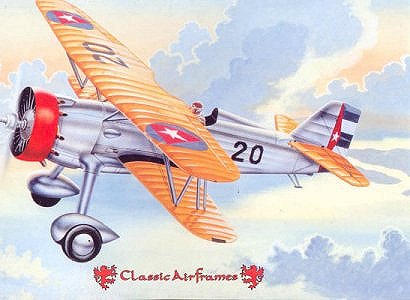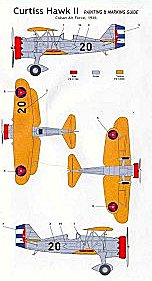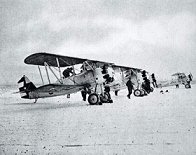

The Cuban Air Force and the President MachadoRuben Urribarres |
![]() The Military Aviation grow
The Military Aviation grow
 When
President General Gerardo Machado Morales, assumed the presidency of the
Republic of Cuba on May 20th of 1925, a few days later on May the 25th, by decree
ordered the reorganization of the Aviation Corp, giving Captain Mario
Torres Menier that responsibility.
When
President General Gerardo Machado Morales, assumed the presidency of the
Republic of Cuba on May 20th of 1925, a few days later on May the 25th, by decree
ordered the reorganization of the Aviation Corp, giving Captain Mario
Torres Menier that responsibility.
Were built three hangars, the building of the Headquarters and were expanded the mechanical section and the Parashot Department. During the government of the president Machado, the army and its small aviation grew in importance.
 Gerardo Machado
Gerardo Machado
In this epoch integrated among others the officers corp of aviators pilots:
Gustavo Alfonso, Pablo Alonso, Aristides Agüero, Miguel de Jesús Bannatyne, José Barrientos, Javier Bazan, Jorge Cao, Miguel A. González, Eduardo Laborde Moliner, Ciro Leonard, Ramiro Leonard, Rogelio Morlote Caballero, Guillermo Martull, Alberto Ponce de León Hernández, José Terry Jimenez, Carlos Torres de Navarra, Alberto Valdes González, Manuel Vidal Lazaga, Guillermo González Vizcay.
In 1925 the US NAVY employs 3 airplanes Loening OA-1 in Cuba to do hidrographical carts of all the island. During the summer of 1926, two Corsairs flew the first international flight of the Cuban aviation from La Habana to Camaguey and continuing to Port Au Prince in Haiti, with Captain Laborde and Lieutenant Martull at the controls.
![]() New equipment acquisitions in 1927-1932
New equipment acquisitions in 1927-1932
In 1927 Captain Rosenham Beam, later a General, together with the Lieutenants Jack Hodgson and James Gillespie and two Master Sergeants mechanics, Joseph Biando y Conrad O�Brian, arrived in Cuba as requested by President Machado, in order to reorganize the Corp and prepare for the expansion. The first action of Beam was to destroy the Jeannys, due to lack of security and this way concentrate on the other QO-2 existing, plus other six airplanes built by the Boeing De Havilland, the D.H 4M-1 (11-12-13-14-15-16) that were purchased before the mission arrived. Immediatedly Beam dedicated himself to securely established, expand and modernize the Air Corp. Ordered the necessary spare parts in order to have he 6 DH 4 ready for combat. This aircraft were damaged by the 1928 hurricane.
Cuba ordered 4 Buffalo Consolidated PT-3 Husky to be used primarily as trainers on February 1928 and incremented the order to total 10 aircraft. Four first, and two more by February 1930. This was the second period of the Air Corp that lasted from 1928 to 1933 and re established the strict system of numbering the aircraft and the PT-3 were numbered (1-2-3-4-5-6-7-8-11-12).
![]() The Curtiss Hawk and Vought Corsair
The Curtiss Hawk and Vought Corsair
With $75,000 it was ordered in October 1929, the first 3 combat Curtiss P-6S Hawk, with WASP engines and eventually the total was raise to 6 (9-10-15-16-17-18), following them 6 Vought O2U-1A Corsairs arrived in May 1939 and another shipment of eight followed up including at least three O2U-3A, followed by more during the period of 1933-34, (24-25-26-27-28-29-30-31-32-33-34). It is believe that Cuba had as many of the O2U-3A aircraft.
  |
| |
In January 1932 arrived at Cuba 4 Curtiss Hawk II, serial (19-20-21-22) and an Aeronca C-3 for training. Probably the first aircraft of this type used at this function in the world. Also used by Captain Laborde in his flight of 2737 miles from Havana to Guatemala City to Mexico City and return to Cuba during the months of April 20 1932 and July 29 of the same year. During the first years of the decade of the thirties, 2 WACOS 9 and two WACOS 10, were donated by the newspaper "El País" and they receive the numbers 13-14, the other two were lost before numbers could be assigned to them.
![]() Lindberg strolls the President
Lindberg strolls the President
8 of February of 1928 arrives at Havana the hero of the aviation Charles Lindberg in friendly visit as part of its rotates by America in its famous "Spirit of St.Louis". That day is declared as "The day of Lindberg". February 12, 1928 the President General Gerardo Machado flies over Havana with Lindberg, being becoming one of the first Leader of State of the world in flying. Later Machado flying as extra crews did a spin in March 2, 1928. After its historic flight over the Atlantic, Lindbergh hit many countries in its airplane and as remembrance of its visits, the flag of these countries was painted in the fuselage. The Cuban flag is the last. After this trip, Lindbergh retired its airplane "Spirit of St. Louis" and it give to the Smithsonian Institute, where today is found in exhibition in the Air & Space Museum, in Washington, D.C.
 | Charles Lindberg and her Spirit of St. Louis with americans flags |
![]() Others illustrious visitors
Others illustrious visitors
The pionero of the Guatemalan aviation, Colonel Miguel García Granados lands June 25, 1929 in the Camp Columbia, Havana, in an international flight of good will Guatemala-Havana-Washington- Mexico-Guatemala. He piloted a Ryan Brougham B-2 call "Guatemala" and the mechanical that accompanied him was Carlos Merlén. García Granados two years later would be appointed leader of the Military Aviation Corp of Guatemala. In Havana received the recognitions of the Cuban town and the President of Cuba Machado condecored him with the Order "Carlos Manuel de Céspedes".
January 29, 1932 is performed in Cuba the
first and last autogyre flight, when the captain Lewis A.Yancey in its autogyre
Keller PCA-2, build in United States by design of the Spanish Juan of the Cierva,
arrives of Miami to Havana. Yancey brought mail. It is the first non-stop
flight among Havana, Cuba and City of Mexico. Previously, August 28, 1928, had
arrived at Havana, originating in City Mexico, Roberto Fierro Villalobos, Major
of the Mexican Air Force, in friendly flight. He arrived at the controls of a
Mexican build airplane, the Baja California N°2, monoplane parasol. Flight
Sevilla-Camaguey.
June 11, 1933 arrives at Camaguey, Cuba, originating in Sevilla, Spain, the historic
airplane "Cuatro Vientos" ("Four Winds"), manned by the Captain Mariano Barberán
and Trós and the Lieutenant Joaquín Collar y Serra, of the spanish
military aviation. The following day they landed in the Airport Columbia in Havana,
Cuba. The details of the flight can be seen in Articles.
 |
The
"Cuatro Vientos" lands in Camaguey. Then, leaving Cuba bound for Mexico, the brave
Spanish aviators Barberán and Collar will disappear for ever |
 |
![]() The Aviation Military School
The Aviation Military School
President Machado re opened the School of Military Aviation, which was recently reconstructed at Campo Columbia, with a modern building equipped with classrooms, laboratory, offices and barracks for twenty-five students on March 5th 1928. The professors at the school were: Lt Colonel Antonio Mesa y Valdes, Captain Armando de la Torre MD, 1st Lt Agustin Rodriguez, 1st Lt Demetrio Ravelo Hernandez, 1st Lt (Pilot) Jose A Terry Jimenez, 1st Lt James Gillespi, 2nd Lt Rogelio Merlotte, 1st Lt Pablo A Rosado Rodriguez, 2nd Lt Faustino Lopez Neira, Captain (Pilot) Mario Torres Menier, Lt Jg (Pilot) Oscar Rivery, Captain Armando Castellan Villgeliu, Captain (Pilot) Eduardo Laborde Moliner, Captain (Pilot) Guillermo Martull and 1st Lt Florindo Fernandez Prieto
The aviation curriculum was divided in two parts, primary training and advance training and the following courses were to be taken: Military Courtesy and Courtesy, Hygiene, Military Administration, Rules and regulations of the Army, Customs of the Service, Infantry and Guard Services, Military Penal Laws and Code of Processing, Air Material Conservation, Aerodynamics, Parachutes, Telegraphy, Aircraft Instruments, International Air Regulations, Maps, Aircraft Alignment, Air Navigation, Air Tactic, Persecution and Attack, Meteorology, Armaments, Gun Sights and Synchronization of Guns, Bombarding, Bomb Sights, Bombs and Explosives, Sign Communication, Air Photography and Observation. This curriculum was updated and more material added as the technology advanced.
The prestige of the Cuban Air Corp was so, those aviation students from Panama,
Dominican Republic and Ecuador received grants to be trained in Cuba as pilots
during 1930 and 1931 and then become the nucleus of their infants Aviation Corp
in their countries. Among them the Dominican aviators Captain Anibal Vallejo,
1st Lt Frank A Feliz Miranda, and the mechanics Gregorio Peguero, Ernesto Tejada
Matos y Andres Rodriguez. Féliz Miranda that received his graduate diplom
from the hands of the President Machado, is considered today precursor of the
Dominican military aviation.
![]() The events of Gibara
The events of Gibara
In August of 1931 in the USA the Democrats were sure of a victory in the next elections due to the prolongacion of the economic depression. Therefore in Cuba the Democrat General Menocal and the Colonel Mendieta organized a sublevation against Machado, but prompt they were trapped. The exiles in New York and their movement Revolutionary Association sent an expedition to Gibara, Province of Oriente, directed by the future President Hevia and the leftist Sergio Carbo. They disembarked in the Bay of Nipe and took the town of Gibara. The Army send to fight thousands of soldiers, and the Air Corp attack. This was the first bombard of a civil population in the history with war airplanes. August 18, 1932 the city of Gibara was bombarded until the rebels abandoned the posicion. The rebels after various days remained without munitions and some they escaped other they were trapped and executed.
Therefore, the revolutionary invasion of Gibara in Oriente Province was defeated by the effective use of the Air Corp, even after losing of 3 airplanes, 2 Corsairs and 1 P-6S, due to the ground fire from the invaders. Took part on the effort the Corsairs aircraft numbered 16-17-26-28-32-33.
![]() Others activities of this period
Others activities of this period
In February 1931, the Cuban Military Army Corp has at least 78 pilots duly trained and formed into two tactical squadrons and 162 ground personnel of different ranks. Captain Beam Left Cuba to the United States in June 1931 to take the Command and Staff courses. The Cuban pilots had the opportunity to show their knowledge when Captain Mario Torres Menier and Lieutenants Pablo Alonso and Rodolfo Herrera, departed in a good will tour through Central America and the southern states of the United States. This flight took effect from September 10th 1933 and returning to Havana October 13th the same year with the Corsairs 27-31 and 32. Were some accidents. On April the 17th of 1928, took of from Campo Columbia Lt Alberto Ponce de Leon Hernandez as flight instructor and Ensign Raul Perez Terrada and were lost forever. During 1933, Lieutenant Manuel Vidal Lazaga and his mechanic suffered a fatal accident, in what is today the head of runway 4 at Camp Columbia.
|
|
|
|
|||



